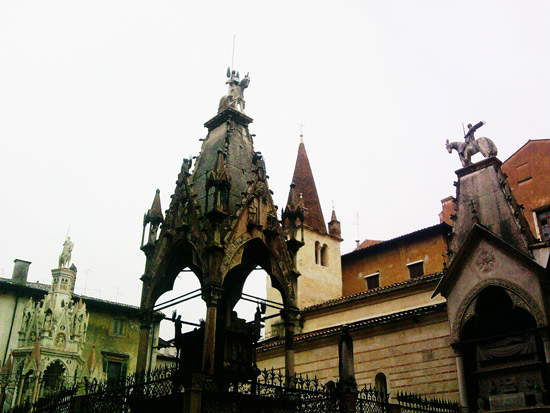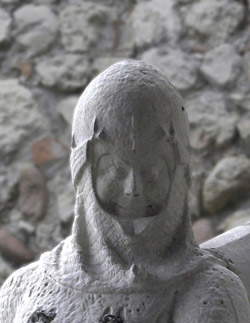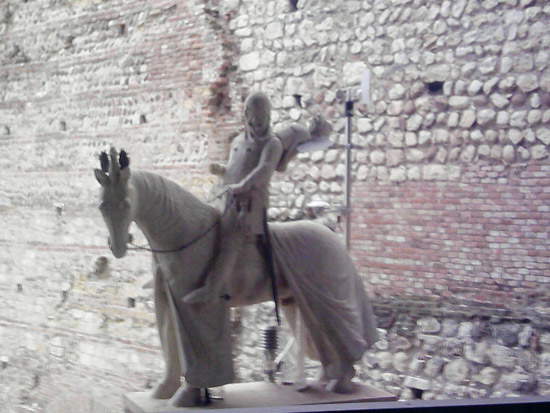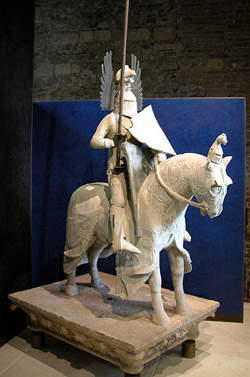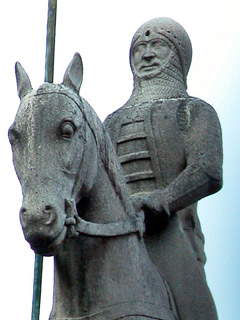by Federico Giannini, Ilaria Baratta , published on 10/06/2015
Categories: Travel
- Opere e artisti / Disclaimer
The Scala arches are the mausoleum of the Della Scala family, which ruled Verona for more than a hundred years. Let us discover this majestic monumental complex.
Walking through the center of Verona, it is impossible not to stop and admire the Scala arches, the ancient tombs of the members of the Scala family, who ruled the fortunes of Verona from 1262 to 1387. Majestic, soaring and monumental, elegant and solemn at the same time, but also a bit eerie with those posing horses mounted by their lords that almost seem to leap off at any moment from the top of the canopy covering the sarcophagi carved to house their bodies, the Scaliger arches are, in addition to being one of the most important monumental complexes in the city, also a remarkable masterpiece of Gothic art, an incredible fusion of sculpture and architecture.
 |
| The Scaliger arches of Verona |
They are located in the medieval heart of Verona, near the church of Santa Maria Antica: we are just a few steps from Piazza dei Signori, the main square of the center. The mausoleum of the Scaligeri is a complex consisting of three main arches, the ones that are best noticed, namely the canopied ones (the oldest is the ark of Cangrande, which was followed by those of Mastino II and Cansignorio) and the tombs of six other members of the family: Mastino I, Alberto I, Bartolomeo, Alboino, Giovanni and Cangrande II. The first of the arks to be made was, as mentioned, that of Cangrande della Scala (1291-1329), perhaps the most famous member of the dynasty, famous also in that he was probably the most sensitive to the arts and letters: in this field we remember above all the famous epistle in which Dante Alighieri dedicates the Paradise of his Comedy to Cangrande.
The ark of Cangrande is leaning against the church of Santa Maria Antica, and it surmounts its entrance: thus, those who enter this church that was dear to the dynasty fulfill an ideal homage to the most illustrious of Verona’s lords. The layout is typical of Gothic art: two columns support a pointed arch on which the baldachin is grafted, and above the top of the latter we find the equestrian monument of Cangrande: what we see today in the small square is a copy, because the original, for conservation reasons, was moved to the Castelvecchio Museum.
 |
| The statue of Cangrande. Credit |
The somewhat sinister figure of the horse wrapped in its wind-whipped caparison and turning sharply toward the observer is counterbalanced by the
smiling face of the gentleman in armor, caught in the act of putting his sword back in its scabbard, symbolizing the peace he was able to establish after many conflicts with neighboring cities: his fellow citizens wanted to sculpt him smiling to recall the benevolence Cangrande had always shown toward Verona. And indeed, the people of Verona have always kept good memories of him. Beneath the tabernacle is the
sarcophagus within which Cangrande rests: it is supported by four dogs (the dog is a Scaligeri symbol, and the names of many family members also attest well to this) that show the observer the family coat of arms (depicting, simply, a ladder), and is decorated with religious and military motifs, such as allegories of the many conquests achieved by Cangrande during his war exploits. The sarcophagus is surmounted by a bed on which lies a statue of the lord, holding his sword in his hands. Cangrande’s ark is believed to be the work of the
Master of St. Anastasia, author of other sculptures found around the city: some are also in the Castelvecchio Museum.
 |
| The statue of Cangrande at the Museo di Castelvecchio |
 |
| The statue of Mastino II at the Castelvecchio Museum. Credit |
We do not know for sure when Cangrande’s ark was made, but we do know for certain that the one for
Mastino II (1308 - 1351), which in chronology follows Cangrande’s, was started in 1345, a few years before the lord’s death, who therefore wanted the ark while he was still alive: the one for Cangrande was instead made after his death. It is not leaning against the church, because it is in an open space, enclosed by a gate: it was therefore designed and carved on four sides. Interestingly, the ark of Mastiff II was originally painted: thus a harmonious balance was sought between sculpture, painting and architecture, the three main arts. The columns support four elegant
trefoil and
cusped pointed arches, i.e., the arches are formed in turn by three small arches and are surmounted by cusps, each of which, in the ark of Mastiff II, houses high reliefs with scenes from
Genesis, symbolizing the terribleness of sin. The canopy has
four aedicules at its corners, which house statues inside them depicting four virtues. Again, the sarcophagus is located under the tabernacle, and on the lid we can observe Mastino’s body, while his equestrian statue dominates the top of the monument. We specify that the equestrian monument of Mastiff II is also a copy, and the original is also in Castelvecchio. The statue is impressive, arousing almost awe, because Mastiff II is fully in armor with his helmet lowered over his face, has his tournament weapons firmly in his hand, and is riding his steed that looks almost ready to go. It was probably Mastino II himself, always thirsty for power (it was in fact he who brought the Scaligera seigniory to its maximum extent), who wanted to have himself represented in that way: if Cangrande thus shows benevolence and cordiality toward his citizens, the image Mastino II wanted to give of himself is that of a proud, powerful, belligerent lord, who sought perhaps to be feared more than to be loved. Note the curious helmet, winged and surmounted by a
dog’s head. We are not sure what connects the dogs to the Scaligeri: it probably stems from the nickname of the first of the family members to become lord of Verona,
Leonardino della Scala, who later went down in history with his nickname
Mastino. Others, on the other hand, relate the dog to the Oriental term
khan, which designated Mongol commanders, but we do not really know if and how the family knew the use of this exotic title.
 |
| Detail of the Cansignorio monument. Credit |
The last of the monumental arks, in chronological order, is that of the ruthless
Cansignorius (1340 - 1375). His rule was marked by conspiracies, crimes and killings, but he too wanted to be remembered with a worthy burial. His ark was begun in 1364, designed by one of the most distinguished sculptors of the time,
Bonino da Campione. And of the three arks, it is the one with the most sumptuous and complex decorative apparatus, a probable reflection of the client’s character: to have it, Cansignorio shelled out ten thousand florins, an extremely considerable sum. Unlike Mastino II’s, which is square in plan, Cansignorio’s has a
hexagonal base and the arches rest on bizarre twisted columns. Cansignorio’s ark is also enclosed, and on the six corners of the enclosure are six aedicules housing six statues of saints: Ludovico, Martino, Sigismondo, Valentino, Giorgio and Luigi, all of whom share the fact that they were warrior saints. The arches supporting the canopy are
polylobate, that is, formed by several small arches, and the sarcophagus stands on a base that is itself raised. The latter is decorated with scenes from the Gospels: prominent in the decoration is the relief with the
Coronation of Mary, in which the figure of Cansignory, who witnesses the scene, also finds space. The arches support the hexagonal canopy, which in turn supports a base, also hexagonal, on which the equestrian monument of the lord finds space. He is the only one of the three who rides a horse without a caparison, and he is depicted riding the animal with a proud and contemptuous gaze, holding a spear.
The tombs of the other lords housed in the complex, on the other hand, are simple sarcophagi, more or less decorated: the oldest one, that of Mastino I, the first Scaliger lord, stands out especially. The work dates back to 1277 and stands out because it is completely devoid of decoration as opposed to that of, for example, Giovanni della Scala, which is more elaborate, with a statue of the Madonna and Child in the center, while on the corners of the sarcophagus niches house statues of saints.
In beautiful Verona, therefore, a stop at this complex is mandatory. It is not only about observing a series of exciting masterpieces of art, and being transported by one of the greatest achievements of Gothic art in the city. It is also and above all a matter of retracing the fascinating epic of a family that for more than a hundred years ruled one of the most powerful cities in Italy, which came to extend its domains as far as the Tyrrhenian Sea, and of celebrating the place of memory of the Scala seigniory and the times when members of the Scala family brought it to its greatest expansion-a place of memory particularly dear to the people of Verona, which has contributed to forming their historical and cultural identity for centuries.
Warning: the translation into English of the original Italian article was created using automatic tools.
We undertake to review all articles, but we do not guarantee the total absence of inaccuracies in the translation due to the program. You can
find the original by clicking on the ITA button. If you find any mistake,please contact us.
